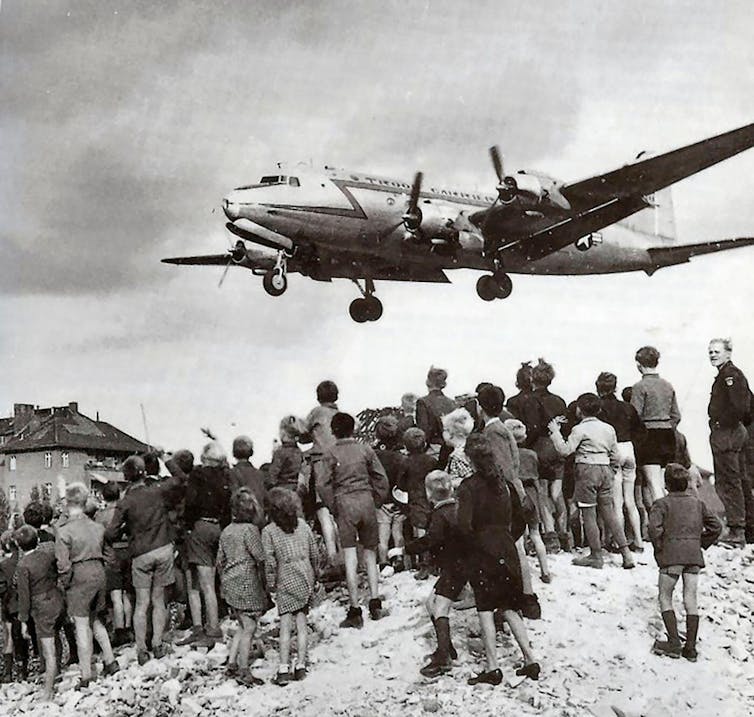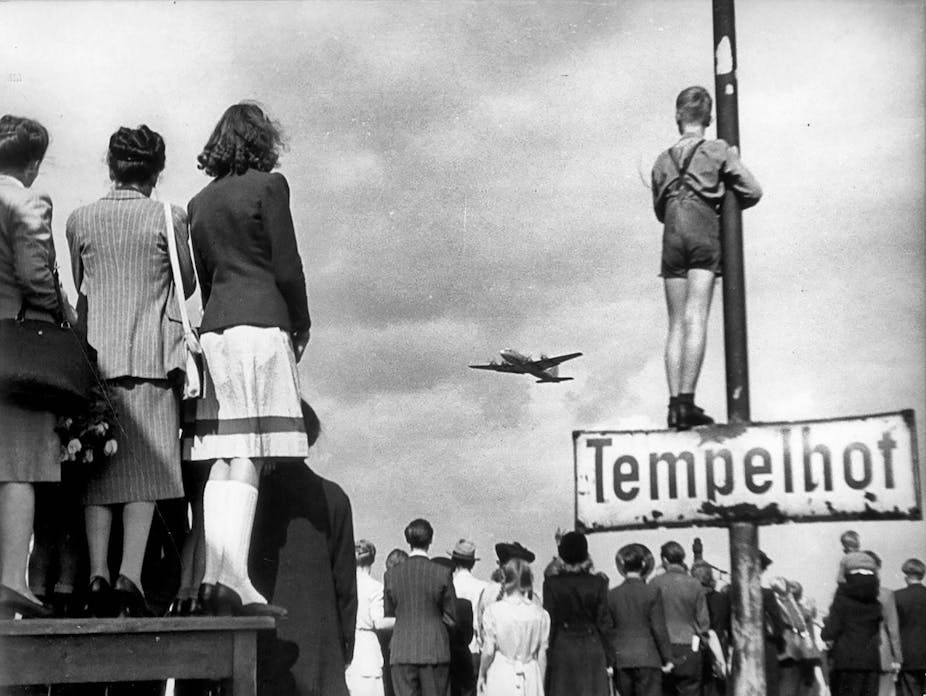A Soviet blockade of the three western sectors of Berlin started on June 24 1948. At that point, the city, like the rest of Germany, was split into areas of Russian, British, US and French control as part of the post-second world war settlement that was shaped in allied conferences in Tehran, Yalta and Potsdam.
For a short period immediately after the end of the war in May 1945, cooperation between the victorious powers administered the city and its residents jointly. But within a year, this initial cooperation was becoming ever more fractious.
By 1948, the rift between the Soviet Union and its one-time western allies had further deepened as a result of the merger of the British and American occupation zones into “Bizonia” – the nucleus of the future west German state. Following Soviet withdrawal from the allied control council, France, Britain and the US introduced a new currency – the Deutschmark – in their sectors on June 24 1948.
The Soviets responded by introducing a separate currency of their own and by blocking all road, rail and canal access to Berlin, triggering the Berlin airlift which supplied civilians and allied forces in the city with food, medicine and coal.
From June 26, the western allies landed flight after flight to sustain the city in the face of Soviet pressure. Realising the futility of their actions, the Soviets lifted the blockade on May 12 1949 and gradually allowed the full restoration of all land and sea connections to the western sectors of Berlin.
None of this would have been possible without the massive effort of the western allies to sustain the city. But the determination of the people of west Berlin, led by their social democratic mayor, Ernst Reuter, not to give in to Soviet blackmail was also vital.
Reuter’s speech on September 9 1948 to a crowd of 300,000 Berliners had a message for the “peoples of America, England, France, Italy”. He called on them not to abandon Berlin, and this was critical in mobilising both the local and international support.

The years between the unconditional German surrender in May 1945 and the autumn of 1949 (the Russian-occupied zones officially became the German Democratic Republic on October 7 1949) were characterised by Soviet efforts to rapidly start building a new communist state.
Read more: Berlin airlift and Ukraine war: the importance of symbols during conflicts
This was part of a Soviet/Russian military culture that is characterised by brutal violence against civilians and cutting off occupied territories as much as possible from the outside world.
The Berlin blockade and later the Berlin wall foreshadowed similar events in the Russian-occupied territories of Georgia after the Russian-Georgian war of 2008. And in relation to today’s Ukraine, this Russian policy is once again on display. The Kremlin continues to deny access for UN aid teams to Russian-controlled territories damaged by the huge Kakhovka dam disaster, which flooded a huge area forcing thousands of people to evacuate and inundating towns and villages.
Similar occupation tactics
The Soviet military administration in Germany had overall control of the eastern occupation zone, as well as east Berlin. German communist party officials, who had fled to Moscow from Nazi persecution and survived Stalin’s purges in the 1930s, coordinated the restoration of local authorities, initially in cooperation with other opponents of the Nazi regime.
Other political parties were officially permitted, but they were quickly marginalised. Within a few years, the system was dominated by pro-Moscow local communists.
This political dominance was further entrenched by reorganisation of other key sectors. On July 1 1945, a local police force was established in east Berlin and the Soviet occupation zone. A year later, the (east) German administration of the interior was created to coordinate various security services including a committee for the protection of all nationalised property, which gradually evolved into the ministry for state security.
This was a similar tactic to the occupied territories of Ukraine from 2014, where the Russians quickly installed local political puppets that are loyal to Moscow. In the summer of 2014, for example, experienced military and secret police operatives were sent to Russian-controlled areas of Donbas with the task of setting up security institutions.
Back in July 1945, a fundamental reform of the education system was launched in east Berlin and the rest of the Soviet zone. It was aimed at indoctrinating the young with Soviet propaganda – similar to the Kremlin’s introduction of the Russian school curriculum in the occupied territories of Ukraine in the summer of 2022.
In east Berlin and elsewhere in Soviet-occupied Germany, newspapers and radio stations were either directly controlled by local communists or their allies. While the nature of media and media consumption has obviously changed since the 1940s, the importance of controlling the media has not – and Moscow has been very effective in taking over local media in the occupied territories of Ukraine, and establishing internet censorship.
As part of de-nazification efforts, “special camps” were established where supporters of the Nazi regime and opponents of Moscow’s Sovietisation policy were interned for years without trial. Similarly, Russia and its local proxies set up “filtration camps” soon after the full-scale invasion of Ukraine in February 2022 – where Ukrainian civilians face abhorrent conditions. Previous instances of wide-scale abuses – abductions, illegal detentions and torture of civilians – in the occupied territories of Donbas were recorded by the UN as early as July 2014.
An unwinnable war for Russia
There is a potential third parallel. No matter how hard today’s Russia might try to break the will of Ukraine and its allies, any occupation may not be permanent. It took almost half a century for the eastern part of Germany to be liberated from Soviet domination. The fall of the Berlin wall in 1989 ushered in changes that ultimately saw a reunited Germany.
Continuing western support for Ukraine’s counteroffensive is essential to ensure Russian occupation of Ukrainian territory does not become as entrenched as it did in East Germany. The lesson from the Berlin airlift must, hopefully, be that any Russian victory will ultimately be pyrrhic and temporary.

